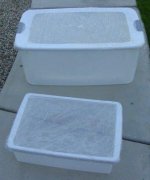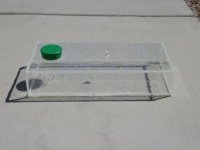LESSON LEARNED – better, cheaper (but still not faster)
(I’m hoping by posting this, that anyone else trying this process will benefit from my mistakes)
Tip: plan it all out first !
I started off by doing the keyboard keys using a small clear plastic kitchen food container with a clear lid.
As I got to bigger parts (ie: cases for the actual computers), I started using larger tubs.

They’re cheap, clear plastic tubs with white tops. I cut the white tops out, and replaced the cut out sections with clear plastic, so I could get UV from the top.
The larger tub has a 29 US gal capacity. The smaller tub has an 8½ US gal capacity.
At a quantity discount cost of $ 20/gal, the larger tub costs $ 290 to fill half full with the H202 solution.
To fill the smaller tub (almost to the brim) costs $ 160.
I needed the larger tub because the Osborne 1 case is one piece (vs the 1a case which is two pieces), and it needed something roughly that size. After processing a bunch of smaller parts, I started with the large case and had to fill the tub up to about 1/2 of capacity, figuring I would turn it over half way through. Afterward, I was left with a huge tub of solution, and I could fit one of the 1a pieces in, but not two. That was an expensive lesson, especially seeing as the solution only lasts for three, maybe four days before it degrades to uselessness.
Then I bought the smaller tub. As you can see, the ½ case piece fits very nicely into the smaller tub.

I figured that was perfect, and would save me some money. After completing the first Osborne 1a, I realized I could do better. It took 5½ gals of solution to cover to a ½” depth over the top of the piece. But there’s a huge space underneath the piece! You can’t put another part in that “void” because it won’t get enough UV, and if you did, it definitely wouldn’t get as much UV as the other part, and wouldn’t de-yellow at the same rate.
I tried putting rocks in the voids, to displace volume and use less solution, but the solution seemed to concentrate on the rocks (they bubble like mad), instead of the plastic parts. I thought of using bricks or concrete blocks, but figured that would be the same as the rocks.
I thought of using plastic orange juice type bottles to displace the solution, but I’ve only got about a 3” high space and the juice bottles I’ve got, are all too big. I thought of using balloons filled with water, but if one broke in the solution, my concentration of H202 would drop, and I’d still be left with a void which would now be filled with a weaker solution.
I wanted something to take up that space, and I‘ve come up with something that is reusable. It’s clear plexiglass (so the UV can still get through), sealed with silicon sealant, and with a plastic juice bottle cap, silicon sealed to the top. It’s the right fit for the actual parts I’m processing.

I’ve made a few of these, in different sizes, that I can place in different configurations, depending on the volume of the tub and the size of piece I’m trying to de-yellow. I can fill these with water (so they won’t float) and put them either in the void space or at the end of the tub (if the part is shorter than the tub), and these things will displace the un-needed volume, while not blocking any UV rays.
The space under the Osborne 1a half case piece, is 665 cu in, which equates to 2.9 US gals. The plexiglass box holds 2 gals of water, cost me $ 12 and it’s reusable (unlike the solution itself, after four days in the sun). I used to need 5½ gals to cover the piece, now I only need 3½ gals. That’s $ 40 less H202 solution, for a $ 12 investment.
If you’re trying to de-yellow a smaller case or part with a void, and need to displace some wasted volume, you may not need a Plexiglass box - you could use a glass cup filled with marbles, or just throw in some marbles. Anything that’s clear and doesn’t float will work.



